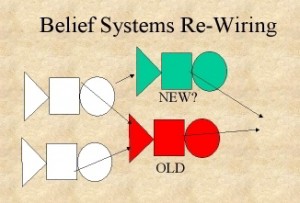
BELIEF CRAFT: Sleight of Mouth on Steroids?
BELIEF CRAFT: Sleight of Mouth on Steroids?
How to “Wire Around” a Negative Belief with Belief Craft
(Look for the Live Belief Craft Seminar in September)
 You know that NLP is all about how humans have a structure to our subjective experience that can be elicited and understood. AND that when you change that structure the subjective experience changes as well. That’s why NLP is so effective at changing subjective experiences like fears or phobias, etc.
You know that NLP is all about how humans have a structure to our subjective experience that can be elicited and understood. AND that when you change that structure the subjective experience changes as well. That’s why NLP is so effective at changing subjective experiences like fears or phobias, etc.
Belief Craft is the marriage of Knowledge Engineering (KE) and Sleight of Mouth (SOM). KE evolved from Jonathan Altfeld’s work as a programmer in the field of Artificial Intelligence (AI). In exploring how to make a computer think like a human (what AI is all about) Jonathan discovered that beliefs are the operative functional units of behavior and that ALL beliefs have the same STRUCTURE. That structure is as follows: Cause – Effect – Meaning. This three part structure is also know as the “Normalized Belief Structure” or NBS.
This NBS was also well known to Robert Dilts, the creator of Sleight of Mouth. SOM also utilized the NBS structure but operates on only segments of the entire structure. SOM offered reframes on either the “Cause-Effect” portion of the belief or the “Effect-Meaning” (aka. the “Complex Equivalence”) part of the belief. It recognizes that the NBS exists as an operative unit, it just doesn’t really treat it as such. This oversight is certainly a result of NLP’s out-of-date belief about beliefs that the “Cause-Effect” and “Complex Equivalence” are two distinct kinds of beliefs. Further elicitation by a person trained in Belief Craft would easily tease out the “Cause” portion of the “Complex Equivalence” or the “Meaning” portion of the “Cause-Effect,” revealing the entire NBS in both cases.
This is why BC can be so much more subtle that SOM and, therefore, more effective.
WIRING AROUND A BELIEF
Let me give you a real life example. I had a Coaching client recently who wanted to lose a few pounds and had never been able to both lose the weight and keep it off. One of the strategies I asked her to adopt was to keep a food journal. I asked her to write down in a little notebook everything she ate everyday. (This strategy is a proven boon to weight loss because it makes unconscious behaviors conscious.)
My client was unable to successfully accomplish simple task. When I asked her what prevented from doing it she said that it just felt like punishment.
I said, “Punishment? What do you mean it feels like punishment?”
She said, “Well, when I’m about to eat something I like I know I’m going to get scolded for it.”
I asked for clarification so I could feel confident I was getting the structure of her belief accurately. “So, IF you eat something you like, THEN you’ll get punished?”
“Yes.”
“So what does getting punished for eating something you like mean to you?”
“It means I’m going to eat in secret.”
“I see.”
I thought for a moment, pondering this. I immediately thought of a number of SOM reframes I could use in that circumstance, but I also wondered how I could use Belief Craft to be even more effective so that old belief of hers just didn’t get fired.
So I back-tracked her belief a bit.
“Does that mean you never eat anything you like and only eat things you don’t like?”
“No. I’ve been making much better food choices lately and learned to like lots of healthy foods. I love fresh seasonal fruit and vegetables and love exploring the farmer’s market and trying new things.”
“And you get punished for that?”
“No! Not for that! Only for things like sweets and chocolate and stuff.”
“Ah. So it’s really IF you eat things like sweets and chocolate, THEN you get punished?”
“Yes.”
“But some foods you can like and NOT get punished for eating?”
“Yes, if they are healthy for me.”
So – what I was noticing here is that her first NBS, “IF I eat something I like, THEN I’ll get punished which MEANS I’m going to eat in secret,” would no longer fire if I could successfully change her belief about what is meant by “a food she likes.”
So I asked her, “What if you knew that there was no such thing as a bad food? What if even sweets and chocolate could be part of a healthy living plan?”
“Well, that’d be great, but its too good to be true.”
“Not at all. Many fit, trim and healthy people include sweets and chocolate in their diet. Dark chocolate is even recommended because of all the anti-oxidants in it. Some people compensate by exercising a little bit more, others just are very cognizant of the amounts they eat and include it in their calorie count for the day. Bottom line is it comes down to Mindfulness. IF you write down what you are eating THEN you are being mindful and that MEANS you can eat those things that make you feel good.”
She paused for a minute, her eyes defocused as if gazing into space.
“IF I write down what I am eating THEN I’m being mindful and that MEANS I can eat those things that make me feel good?”
“Yes.”
“OK.” She said brightly. “I can see that.”
This new belief had the added benefit of being true, in my model of the world at least, so that always makes things easier. It certainly appeared that this use of Belief Craft had worked like a charm. She began writing down everything she ate and, from that day forward, she is happily losing weight and getting trim in a way that she’ll be able to maintain for a lifetime. The old NBS just doesn’t fire anymore, thanks to Belief Craft.




 Download Doug O’Brien’s paper,
“Be your Best with Self Hypnosis”
Download Doug O’Brien’s paper,
“Be your Best with Self Hypnosis”